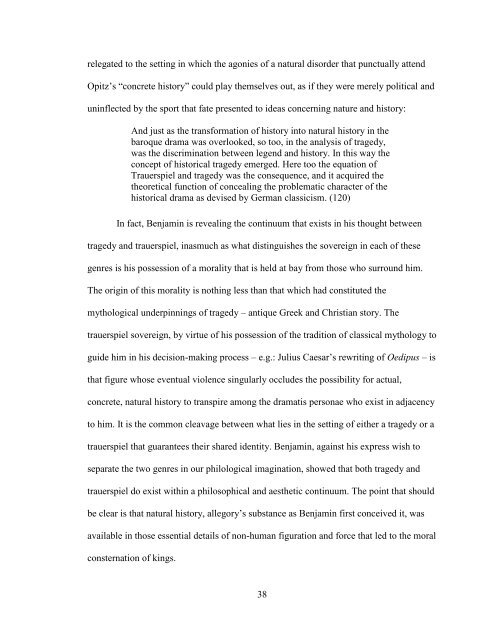TABOO: THE ACTUAL MODERNIST AESTHETIC, MADE REAL A ...
TABOO: THE ACTUAL MODERNIST AESTHETIC, MADE REAL A ...
TABOO: THE ACTUAL MODERNIST AESTHETIC, MADE REAL A ...
Create successful ePaper yourself
Turn your PDF publications into a flip-book with our unique Google optimized e-Paper software.
elegated to the setting in which the agonies of a natural disorder that punctually attend<br />
Opitz‟s “concrete history” could play themselves out, as if they were merely political and<br />
uninflected by the sport that fate presented to ideas concerning nature and history:<br />
And just as the transformation of history into natural history in the<br />
baroque drama was overlooked, so too, in the analysis of tragedy,<br />
was the discrimination between legend and history. In this way the<br />
concept of historical tragedy emerged. Here too the equation of<br />
Trauerspiel and tragedy was the consequence, and it acquired the<br />
theoretical function of concealing the problematic character of the<br />
historical drama as devised by German classicism. (120)<br />
In fact, Benjamin is revealing the continuum that exists in his thought between<br />
tragedy and trauerspiel, inasmuch as what distinguishes the sovereign in each of these<br />
genres is his possession of a morality that is held at bay from those who surround him.<br />
The origin of this morality is nothing less than that which had constituted the<br />
mythological underpinnings of tragedy – antique Greek and Christian story. The<br />
trauerspiel sovereign, by virtue of his possession of the tradition of classical mythology to<br />
guide him in his decision-making process – e.g.: Julius Caesar‘s rewriting of Oedipus – is<br />
that figure whose eventual violence singularly occludes the possibility for actual,<br />
concrete, natural history to transpire among the dramatis personae who exist in adjacency<br />
to him. It is the common cleavage between what lies in the setting of either a tragedy or a<br />
trauerspiel that guarantees their shared identity. Benjamin, against his express wish to<br />
separate the two genres in our philological imagination, showed that both tragedy and<br />
trauerspiel do exist within a philosophical and aesthetic continuum. The point that should<br />
be clear is that natural history, allegory‘s substance as Benjamin first conceived it, was<br />
available in those essential details of non-human figuration and force that led to the moral<br />
consternation of kings.<br />
38
















